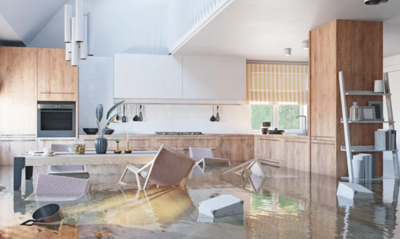
Water damage isn’t just an inconvenience—it’s a serious issue that can compromise the structure, safety, and livability of a home. When the damage is severe, a full remodel may be necessary, involving everything from demolition and mold removal to rebuilding and redesigning key parts of the house.
But remodeling after water damage requires more than just cosmetic fixes. It demands a detailed, cautious approach to ensure the home is safe, dry, and fully restored. And depending on where you live, climate factors can significantly influence both the causes of damage and the restoration process.
Here’s what to look out for and how to tackle a water-damaged home remodel the right way.
Start With a Full Assessment
Before lifting a hammer or ordering materials, get a professional damage assessment. You’ll need to understand:
How deep the water infiltration went
Whether the foundation or structural framing was compromised
The presence of mold or rot
Electrical and plumbing system impact
Potential contamination (especially if flooding involved sewage or stormwater)
A licensed inspector or structural engineer can help identify both visible and hidden damage, which is crucial when planning the remodel. Skipping this step could lead to costly surprises later—and even put your safety at risk.
Prioritize Safety and Mold Remediation
Water and moisture are the perfect breeding ground for mold, and mold can start growing in as little as 24 to 48 hours. If not handled correctly, mold can spread throughout the home and pose serious health risks to occupants and contractors.
Professional remediation teams should handle mold removal, particularly if the infestation is extensive. This includes:
Using HEPA filtration systems
Removing contaminated materials like drywall and insulation
Proper disposal of debris
Treating affected areas with antimicrobial solutions
Even after visible mold is removed, moisture monitoring tools should be used to ensure that surfaces are truly dry before rebuilding begins.
The Centers for Disease Control and Prevention (CDC) offers guidance on mold cleanup and safety procedures, which can be accessed here:
Understand How Climate Affects Water Damage Recovery
Remodeling after water damage looks different depending on where you are in the U.S. For example:
In humid states like Florida or Louisiana, high moisture levels can prolong drying times and increase the risk of mold. Dehumidifiers and ventilation are especially critical during the remodeling phase.
In cold states like Minnesota or Vermont, water damage may result from frozen and burst pipes. Here, insulation upgrades and plumbing replacements are often part of the remodel to prevent future issues.
In desert climates like Arizona or Texas, even small leaks can go unnoticed longer due to the dry air, which can result in slow but widespread structural damage, especially to foundations and walls. You can find out more about water damage restoration here.
Each climate zone requires different building materials, remediation techniques, and preventive measures. That’s why it’s important to work with local contractors or restoration professionals who understand the unique challenges in your region.
Replace, Don’t Repair, Critical Components
In a water-damaged home, it’s often safer—and smarter—to replace rather than repair key elements like:
Insulation
Drywall
Carpeting and underlayment
Electrical wiring
Subflooring
Even if these components appear dry or intact, water exposure can compromise their integrity or leave behind contaminants that aren't visible. Replacing them ensures you’re starting fresh with safe, mold-free materials.
For homeowners concerned about budget, focus on replacing components that contribute to structural safety and air quality first. Finishes and cosmetic updates can follow in phases if needed.
Plan for Code Compliance and Upgrades
During a major remodel, you’ll likely need to bring the home up to current building codes—especially if it’s an older property. This could involve electrical rewiring, updated plumbing systems, or better ventilation and insulation.
In some states, homes located in designated flood zones may also need to be elevated, retrofitted, or rebuilt with flood-resistant materials in compliance with FEMA and local ordinances. These upgrades add upfront cost but are essential for long-term safety, insurability, and peace of mind.
Consult your local building department to understand what’s required and whether permits or inspections are necessary. Skipping this step can lead to fines, insurance headaches, and potential hazards.
Showcase the Rebuild With Visual Documentation
If you're a contractor, property investor, or homeowner planning to sell post-remodel, visual documentation of the restoration can be a powerful tool. Use high-quality photos, before-and-after comparisons, and printed or digital handouts to showcase:
The original damage
Steps taken during remediation
Code upgrades and improvements
Final results
Not only does this build trust with potential buyers or tenants, but it also shows insurers, lenders, and inspectors that the rebuild was done professionally and thoroughly.
These handouts can also be useful during appraisals and resale negotiations, helping justify the property’s updated value and ensuring transparency throughout the transaction.
Repair With the Future in Mind
Remodeling a home after severe water damage isn’t just about repairing what’s broken—it’s about building smarter, preventing future issues, and creating a safe, healthy space that will last for years to come.
From climate-specific materials to mold remediation and structural upgrades, every decision you make should prioritize safety, durability, and compliance. Surround yourself with experienced professionals, follow proper guidelines, and document the process carefully.
With the right approach, what starts as a setback can become a major opportunity—not just to restore your home, but to improve it in meaningful, lasting ways.


(0) comments
We welcome your comments
Log In
Post a comment as Guest
Keep it Clean. Please avoid obscene, vulgar, lewd, racist or sexually-oriented language.
PLEASE TURN OFF YOUR CAPS LOCK.
Don't Threaten. Threats of harming another person will not be tolerated.
Be Truthful. Don't knowingly lie about anyone or anything.
Be Nice. No racism, sexism or any sort of -ism that is degrading to another person.
Be Proactive. Use the 'Report' link on each comment to let us know of abusive posts.
Share with Us. We'd love to hear eyewitness accounts, the history behind an article.